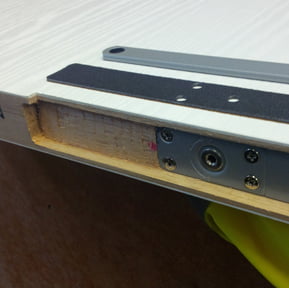
This article was originally published in July 2015, and was updated in 2024 to reflect changes in construction and fire safety legislation since then.
Do you have an issue with a door closer you’re struggling to solve? Here’s your chance to get it sorted once and for all.
Welcome to the first post in our quarterly Door Closer Conundrum series, in which our specialists shed light on common door closer problems.
First up is a conundrum relating to a customer who was designing a new door and frame: he wanted to expand his portfolio to include a fire-rated composite door in a wooden frame. For the door control he chose a Rutland concealed closer with an intumescent pack for fire rating.
This is where the uncertainty set in. When it came to fitting the actual unit in the door, the customer became concerned he wasn’t doing it properly, and that as a result the doorset might fail its fire test.
A fire-rating test at a UK-designated body (or "EU notified body" for CE Marking) not only requires a sizable investment, but the waiting list can delay a product launch for many months. Manufacturers don't want a product to fail in a UKCAS third-party lab test on something that could have been discovered and rectified beforehand.
It’s a concern we often hear, and here’s how we solved this conundrum.
1. We checked the doorset at our in-house test facility before it was sent to a UKAS-approved test house. First, we ensured the closer was fitted properly. With slight adjusting, we were able to fit the door closer accurately and put it on our test rig in our studio. In addition to the continuity of components and materials, it is also crucial that the production process (FPC, or factiry process control), and final fitting remain consistent with the original sample tested.
2. We put the doorset through its paces. This rigorous testing included opening and shutting the door with speed and vigour to try and get it to break. The opening and closing moments were tested on the doorset and came up trumps – they exceeded the necessary Equalities Act (DDA) requirements.
The pressure test was done on the push side and the pull side to ensure minimum EN 3 size for the fire regulations, as well as ease of access for the elderly or infirm. We checked this against the DoP of the product. The results exceeded the recommended minimum.
Of course, only an approved test house can ascertain the actual fire-rating, but using all available experience and in-house testing can remove the wastage of time and budget in bringing new product designs through to compliance.
As simple as it sounds, if you’re not sure if your doorset will meet current fire testing standards, seek specialist advice. Given that testing has cost and scheduling implications, this will help you keep projects on budget and on schedule.
Have you got a door closer conundrum you’d like us to solve? Share it with us by using this form.
Leave us your contact details and we will call you back for a free consultation about your requirements.